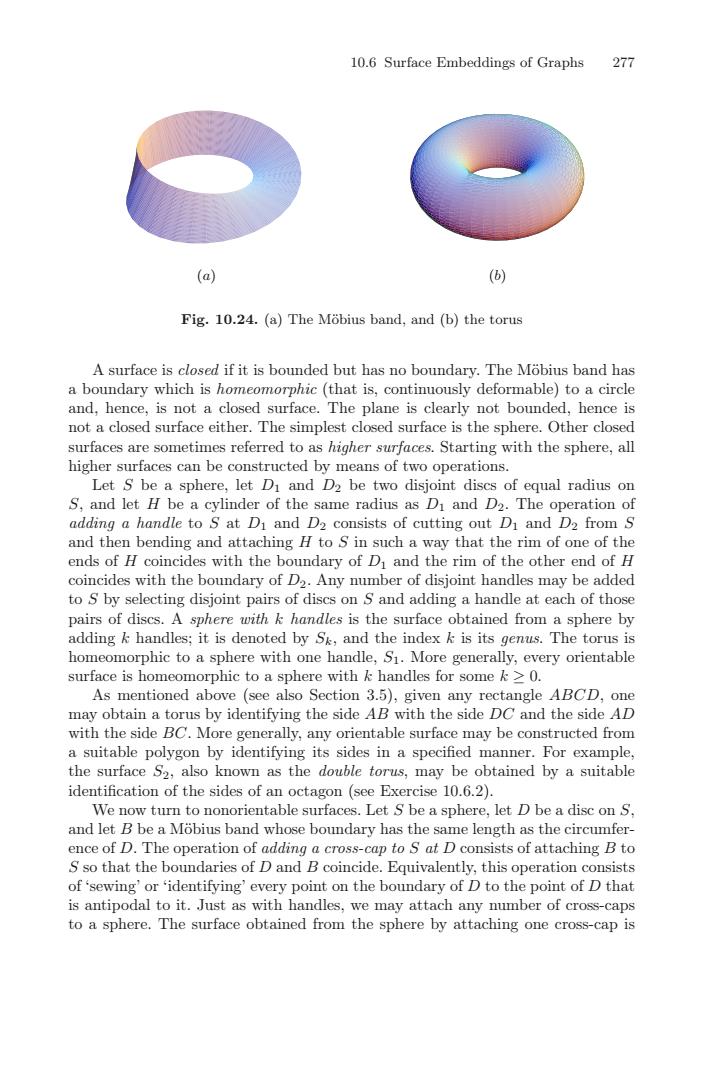正在加载图片...

2770.lingsofGraphs(a)(6)Fig. 10.24. (a) The Mobius band, and (b) the torusA surface is closed if it is bounded but has no boundary.The Mobius band hasa boundary which is homeeomorphic (that is, continuously deformable) to a circleand, hence, is not a closed surface.The plane is clearly not bounded, hence isnot a closed surface either.The simplest closed surface is the sphere. Other closedsurfaces are sometimes referred to as higher surfaces. Starting with the sphere, allhigher surfaces can be constructed by means of two operations.Let S be a sphere.let D, and D2be two disjoint discs of egual radius onS.and let H becylinder of these radius as Dr and D2.The operation ofaddingahandletoSatDiand Daconsists of cutting out Dr and Dafromsand thenbending and attaching H to S in such a way that tl01im of oneof theends of H coirwiththendary of Dr and the rim of the other end of Hcoincides with thebdary of D,Any number of disjoint handles may be addedto S by selecting disjoint pairs of discs on S and adding a handle at each of thosepairs of discs. A sphere with k handles is the surface obtained from a sphere byadding k handles; it is denoted by Sk, and the index k is its genus. The torus ishomeomorphic to a sphere with one handle, Si. More generally, every orientablesurfaceishomeomorphictoa spherewithkhandlesforsomek>0Asmentioned above (see also Section3.5),givenanyrectangleABCDomay obtain a torus by identifying the side AB with the side DC and the side ADwith the side BC. Moreenerally, any orientable surfacemay be constructed froma suitable polygon by identifying its sides in a specified maer.Forexamplethe surface S2, also known as the double torus, may be obtained by a suitableidentification of the sides of an octagon (see Exercise 10.6.2)We now turn to nonorientable surfaces. Let S be a sphere, let D be a disc on S.and let B be a Mobius band whose boundary has the same length as the circumferenceof D.Theoperationof adding across-captoSatD consistsofattachingBtoS so that the boundaries of D and B coincide.Equivalently,this operation consistsof sewing' or identifying' every point on the boundary of D to the point of D thatis antipodal toit.Just as with handles, we may attach annumber of cross-capsto a sphere. The surface obtained from the sphere by attaching one cross-capis10.6 Surface Embeddings of Graphs 277 (a) (b) Fig. 10.24. (a) The M¨obius band, and (b) the torus A surface is closed if it is bounded but has no boundary. The M¨obius band has a boundary which is homeomorphic (that is, continuously deformable) to a circle and, hence, is not a closed surface. The plane is clearly not bounded, hence is not a closed surface either. The simplest closed surface is the sphere. Other closed surfaces are sometimes referred to as higher surfaces. Starting with the sphere, all higher surfaces can be constructed by means of two operations. Let S be a sphere, let D1 and D2 be two disjoint discs of equal radius on S, and let H be a cylinder of the same radius as D1 and D2. The operation of adding a handle to S at D1 and D2 consists of cutting out D1 and D2 from S and then bending and attaching H to S in such a way that the rim of one of the ends of H coincides with the boundary of D1 and the rim of the other end of H coincides with the boundary of D2. Any number of disjoint handles may be added to S by selecting disjoint pairs of discs on S and adding a handle at each of those pairs of discs. A sphere with k handles is the surface obtained from a sphere by adding k handles; it is denoted by Sk, and the index k is its genus. The torus is homeomorphic to a sphere with one handle, S1. More generally, every orientable surface is homeomorphic to a sphere with k handles for some k ≥ 0. As mentioned above (see also Section 3.5), given any rectangle ABCD, one may obtain a torus by identifying the side AB with the side DC and the side AD with the side BC. More generally, any orientable surface may be constructed from a suitable polygon by identifying its sides in a specified manner. For example, the surface S2, also known as the double torus, may be obtained by a suitable identification of the sides of an octagon (see Exercise 10.6.2). We now turn to nonorientable surfaces. Let S be a sphere, let D be a disc on S, and let B be a M¨obius band whose boundary has the same length as the circumference of D. The operation of adding a cross-cap to S at D consists of attaching B to S so that the boundaries of D and B coincide. Equivalently, this operation consists of ‘sewing’ or ‘identifying’ every point on the boundary of D to the point of D that is antipodal to it. Just as with handles, we may attach any number of cross-caps to a sphere. The surface obtained from the sphere by attaching one cross-cap is